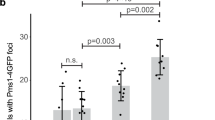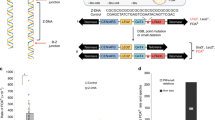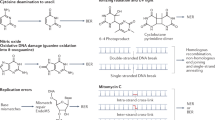Abstract
ACQUIRED resistance to alkylating agents such as N-methyl-N-nitrosourea or N-methyl-N′ -nitro-N-nitrosoguanidine results from the ability to tolerate the potentially cytotoxic methylated base O6-methylguanine (m6-G) in DNA. In the absence of repair by demethylation in situ, m6-G is probably lethal through its inappropriate processing by the cell1. DNA mismatch correction is an attractive candidate for the processing function because although it is replicated, m6-G has no perfect complementary base. Thus, m6-G in DNA might provoke abortive mismatch repair and tolerance could subsequently arise through loss of a mismatch repair pathway2,3. Mismatch correction helps maintain genomic fidelity by removing misincorporated bases and deaminated 5-methylcytosine from DNA, and its loss by mutation confers a mutator phenotype on Escherichia coli4,5. Here we describe human and hamster cell lines that are tolerant to N-methyl-N-nitrosourea and are defective in a DNA mismatch binding activity. The loss of this activity, which acts on G-T mispairs, confers a mutator phenotype.
This is a preview of subscription content, access via your institution
Access options
Subscribe to this journal
Receive 51 print issues and online access
$199.00 per year
only $3.90 per issue
Buy this article
- Purchase on Springer Link
- Instant access to full article PDF
Prices may be subject to local taxes which are calculated during checkout
Similar content being viewed by others
References
Karran, P. & Bignami, M. Nucleic Acids Res. 20, 2933–2940 (1992).
Karran, P. & Marinus, M. G. Nature 296, 868–869 (1982).
Goldmacher, V. S., Cuzick, R. A. & Thilly, W. G. J. biol. Chem. 261, 12462–12471 (1986).
Cox, E. C. A. Rev. genet. 10, 135–156 (1976).
Lieb, M. Genetics 128, 23–27 (1991).
Karran, P., Stephenson, C., Macpherson, P., Cairns-Smith, S. & Priestley, A. Cancer Res. 50, 1532–1537 (1990).
Aquilina, G. et al. Carcinogenesis 9, 1217–1222 (1988).
Aquilina, G., Zijno, A., Moscufo, N., Dogliotti, E. & Bignami, M. Carcinogenesis 10, 1219–1223 (1989).
Jiricny, J., Hughes, M., Corman, N. & Rudkin, B. B. Proc. natn. Acad. Set. U.S.A. 85, 8860–8864 (1988).
Stephenson, C. & Karran, P. J. biol. Chem. 264, 21177–21182 (1989).
Borts, R. H. et al. Genetics 124, 573–584 (1990).
Phear, G., Armstrong, W. & Meuth, M. J. molec. Biol. 209, 577–582 (1989).
McGregor, W. G., Maher, V. M. & McCormick, J. J. Somatic Cell and Molecular Genetics 17, 463–469 (1991).
Rewinski, C. & Marinus, M. G. Nucleic Acids Res. 15, 8205–8215 (1987).
Schaaper, R. M. & Dunn, R. L. Proc. natn. Acad. Sci. U.S.A. 84, 6220–6224 (1987).
Fleck, O., Michael, H. & Heim, L. Nucleic Acids Res. 20, 2271–2278 (1992).
Fujii, H. & Shimada, T. J. biol. Chem. 264, 10057–10064 (1989).
Linton, J. P. et al. Molec. cell. Biol. 9, 3058–3072 (1989).
Modrich, P. J. biol. Chem. 264, 6597–6600 (1989).
Luria, S. E. & Delbrück, M. Genetics 28, 491–511 (1943).
Lea, D. E. & Coulson, C. A. J. Genet. 49, 264–285 (1949).
Author information
Authors and Affiliations
Rights and permissions
About this article
Cite this article
Branch, P., Aquilina, G., Bignami, M. et al. Defective mismatch binding and a mutator phenotype in cells tolerant to DNA damage. Nature 362, 652–654 (1993). https://doi.org/10.1038/362652a0
Received:
Accepted:
Issue Date:
DOI: https://doi.org/10.1038/362652a0
This article is cited by
-
A specific mode of microsatellite instability is a crucial biomarker in adult T-cell leukaemia/lymphoma patients
Journal of Cancer Research and Clinical Oncology (2017)
-
Apoptosome activation, an important molecular instigator in 6-mercaptopurine induced Leydig cell death
Scientific Reports (2015)
-
YB-1 disrupts mismatch repair complex formation, interferes with MutSα recruitment on mismatch and inhibits mismatch repair through interacting with PCNA
Oncogene (2014)
-
Balancing repair and tolerance of DNA damage caused by alkylating agents
Nature Reviews Cancer (2012)
-
Somatic deletions of genes regulating MSH2 protein stability cause DNA mismatch repair deficiency and drug resistance in human leukemia cells
Nature Medicine (2011)
Comments
By submitting a comment you agree to abide by our Terms and Community Guidelines. If you find something abusive or that does not comply with our terms or guidelines please flag it as inappropriate.



